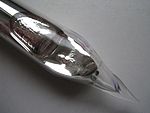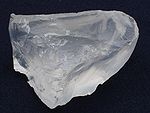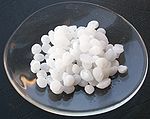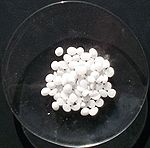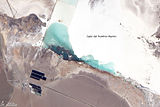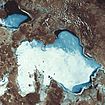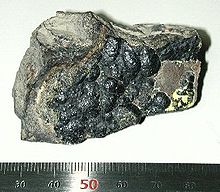- Alkali metal
-
Group → 1 ↓ Period 2 
3
Li3 
11
Na4 
19
K5
37
Rb6 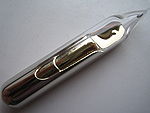
55
Cs7 87
Fr
Legend Alkali metal Primordial Natural Ratio The alkali metals are a series of chemical elements in the periodic table. In the modern IUPAC nomenclature, the alkali metals comprise the group 1 elements, along with hydrogen. The alkali metals are lithium (Li), sodium (Na), potassium (K), rubidium (Rb), caesium (Cs), and francium (Fr).[1] Hydrogen (H), although nominally also a member of Group 1,[2] rarely exhibits behavior comparable to the alkali metals. This group lies in the s-block of the periodic table; all alkali metals' outermost electrons lie in an s-orbital. The alkali metals provide one of the best examples of group trends in properties in the periodic table, with elements exhibiting well characterized homologous behavior. For instance, when moving down the table, all alkali metals show decreasing electronegativity, increasing reactivity, and decreasing melting and boiling points. In general, their densities increase, with the notable exception that potassium is less dense than sodium.
All discovered alkali metals are naturally occurring, although francium is the second-rarest naturally occurring element, after astatine. All are highly reactive metals under standard conditions. Experiments have been conducted to attempt the synthesis of ununennium (Uue), likely the next member of the group, but have all met with failure, but because all elements with lower atomic numbers have been discovered, it is likely[3] to be found in the near future. However, ununennium may not be an alkali metal due to relativistic effects.
Contents
Hydrogen
Main article: HydrogenThe element hydrogen, with one electron per neutral atom, is usually placed at the top of Group 1 of the periodic table for convenience, but hydrogen is not usually considered as an alkali metal. Under typical conditions, pure hydrogen exists as a diatomic gas consisting of two atoms per molecule (H2).
Hydrogen, like the other alkali metals, has one valence electron; however, the similarities end there. In fact, its placement above lithium is primarily due to its electron configuration and not its chemical properties.[2] It is sometimes placed above carbon due to similar electronegativity[4] or fluorine due to similar chemical properties.[4]
The first ionization energy of hydrogen is much higher than that of the alkali metals. As only one additional electron is required to fill in the outermost shell of the hydrogen atom, hydrogen often behaves like a halogen, forming the negative hydride ion. Binary compounds of hydrogen with the alkali metals and some transition metals have been produced in the laboratory[5], but these are only laboratory curiosities without any practical use. Under extremely high pressures and low temperatures, however, such as those found at the cores of the planets Jupiter and Saturn, hydrogen does become metallic[6] and behaves like an alkali metal; in this phase, it is known as metallic hydrogen.
Characteristics
Chemical
Like other groups, the members of this family show patterns in its electronic configuration, especially the outermost shells, resulting in trends in chemical behavior:
Z Element No. of electrons/shell Electron configuration 3 lithium 2, 1 [He]2s1 11 sodium 2, 8, 1 [Ne]3s1 19 potassium 2, 8, 8, 1 [Ar]4s1 37 rubidium 2, 8, 18, 8, 1 [Kr]5s1 55 caesium 2, 8, 18, 18, 8, 1 [Xe]6s1 87 francium 2, 8, 18, 32, 18, 8, 1 [Rn]7s1 Most of the chemistry has been observed only for the first five members of the group. The chemistry of francium is not very established and therefore the rest of this section does not deal with it. All the alkali metals are all highly reactive and are never found in elemental forms in nature. Because of this, they are usually stored in mineral oil or kerosene (paraffin oil).[7]
H He Li Be B C N O F Ne Na Mg Al Si P S Cl Ar K Ca Sc Ti V Cr Mn Fe Co Ni Cu Zn Ga Ge As Se Br Kr Rb Sr Y Zr Nb Mo Tc Ru Rh Pd Ag Cd In Sn Sb Te I Xe Cs Ba * Hf Ta W Re Os Ir Pt Au Hg Tl Pb Bi Po At Rn Fr Ra ** Rf Db Sg Bh Hs Mt Ds Rg Cn Uut Uuq Uup Uuh Uus Uuo * La Ce Pr Nd Pm Sm Eu Gd Tb Dy Ho Er Tm Yb Lu ** Ac Th Pa U Np Pu Am Cm Bk Cf Es Fm Md No Lr Alkali metals in the periodic table Hydrogen in the periodic table Caesium reacts explosively with water even at low temperatures
The alkali metals are all silver-colored except for metallic caesium, which can have a golden tint. All are soft and have low density, melting points, and boiling points. In chemical terms, all of the alkali metals react aggressively with the halogens to form ionic salts, and also react with water to form strongly alkaline hydroxides. The heavier alkali metals react more vigorously than the lighter ones; caesium produces much bigger explosions when dropped in water than potassium, for example. The alkali metals have the lowest first ionization energies in their respective periods of the periodic table because of their low effective nuclear charge and the ability to attain noble gas configuration by losing just one electron. The second ionization energy of all of the alkali metals is very high, thus they almost always lose a single electron, forming cations
Alkali metals form a very wide range of amalgams.[8] They tend to form ionically bonded salts with most electronegative elements on the periodic table, for example caesium fluoride and sodium chloride.
The ammonium ion (NH+
4) has very similar properties to the heavier alkali metals and is often considered a close relative.[9]Physical and atomic
The table below is a summary of the key physical properties of the alkali metals. The density of Francium is an estimation partially based on periodic trends rather than observations.[10]
Group 1 element Standard atomic weight (u) Melting point (K) Melting point (°C) Boiling point (K) Boiling point (°C) Density (g/cm3) Electronegativity (Pauling) Lithium 6.941 454 180.5 1615 1342 0.534 0.98 Sodium 22.98976928 370 97.8 1156 883 0.968 0.93 Potassium 39.0983 336 63.38 1032 759 0.89 0.82 Rubidium 85.4678 312 39.31 961 688 1.532 0.82 Caesium 132.9054519 301 28.44 944 671 1.93 0.79 Francium (223) 300.15 27 950.15 677 1.87 0.70 History
Lithium
Petalite (LiAlSi4O10) was discovered in 1800 by the Brazilian chemist José Bonifácio de Andrada e Silva in a mine on the island of Utö, Sweden.[11][12][13] However, it was not until 1817 that Johan August Arfwedson, then working in the laboratory of the chemist Jöns Jakob Berzelius, detected the presence of a new element while analyzing petalite ore.[14][15][16] This new element formed compounds similar to those of sodium and potassium, though its carbonate and hydroxide were less soluble in water and more alkaline than the other alkali metals'.[17] Berzelius gave the unknown material the name "lithion/lithina", from the Greek word λιθoς (transliterated as lithos, meaning "stone"), to reflect its discovery in a solid mineral, as opposed to potassium, which had been discovered in plant ashes, and sodium, which was known partly for its high abundance in animal blood. He named the metal inside the material "lithium".[12][16][18]
Sodium
Although sodium has long been recognized in compounds, it was not isolated until 1807 by Humphry Davy through the electrolysis of caustic soda,[19] a very similar method to the one used to isolate potassium earlier that year.
Potassium
Potassium metal was first isolated in 1807 in England by Sir Humphry Davy, who derived it from caustic potash (KOH) by the use of electrolysis of the molten salt with the newly invented voltaic pile. Potassium was the first metal that was isolated by electrolysis.[20] Later that same year, Davy reported extraction of the metal sodium from the similar substance caustic soda (NaOH, or lye) by a similar technique, demonstrating the elements, and thus the salts, to be different.[19][21][22][23]
Rubidium
Rubidium was discovered in 1861 in Heidelberg, Germany by Robert Bunsen and Gustav Kirchhoff, the first people to suggest finding new elements by spectrum analysis, in the mineral lepidolite through the use of a spectroscope. Because of the bright red lines in its emission spectrum, they chose a name derived from the Latin word rubidus, meaning dark red.[24][25] Rubidium's discovery succeeded that of caesium, also discovered by Bunsen and Kirchhoff through spectroscopy.
Caesium
In 1860, Robert Bunsen and Gustav Kirchhoff discovered caesium in the mineral water from Dürkheim, Germany. Due to the bright-blue lines in its emission spectrum, they chose a name derived from the Latin word caesius, meaning sky-blue.[24][25][26][27] Caesium was the first element to be discovered spectroscopically, only one year after the invention of the spectroscope by Bunsen and Kirchhoff.[28]
Francium
There were at least three erroneous and incomplete discoveries[29][30][31][32] before Marguerite Perey of the Curie Institute in Paris, France discoverd Francium in 1939 by purifying a sample of actinium-227, which had been reported to have a decay energy of 220 keV. However, Perey noticed decay particles with an energy level below 80 keV. Perey thought this decay activity might have been caused by a previously unidentified decay product, one that was separated during purification, but emerged again out of the pure actinium-227. Various tests eliminated the possibility of the unknown element being thorium, radium, lead, bismuth, or thallium. The new product exhibited chemical properties of an alkali metal (such as coprecipitating with caesium salts), which led Perey to believe that it was element 87, caused by the alpha decay of actinium-227.[33] Perey then attempted to determine the proportion of beta decay to alpha decay in actinium-227. Her first test put the alpha branching at 0.6%, a figure that she later revised to 1%.[34]
Eka-francium
See also: Extended periodic tableThe next element below francium (Eka-francium) is likely to be ununennium (Uue), element 119, although this is not certain. The synthesis of ununennium was first attempted in 1985 by bombarding a target of einsteinium-254 with calcium-48 ions at the superHILAC accelerator at Berkeley, California. No atoms were identified, leading to a limiting yield of 300 nb.[35][36]

It is highly unlikely[3] that this reaction will be able to create any atoms of ununennium in the near future, given the extremely difficult task of making sufficient amounts of 254Es to make a large enough target to increase the sensitivity of the experiment to the required level; einsteinium has not been found in nature and has only been produced in laboratories. However, given that ununennium is only the first period 8 element on the extended periodic table, it may well be discovered in the near future through other reactions.[3] Currently, none of the period 8 elements have been discovered yet. It is also possible that, due to drip instabilities, only the lower period 8 elements are physically possible.Production
Salt flats are rich in lithium, such as these in Salar del Hombre Muerto, Argentina (left) and Uyuni, Bolivia (right). The lithium-rich brine is concentrated by pumping it into solar evaporation ponds (visible in Argentina image).The production of pure alkali metals is difficult due to their extreme reactivity with commonly used substances, such as water. Lithium salts have to be extracted from the water of mineral springs, brine pools, and brine deposits. The metal is produced electrolytically from a mixture of fused lithium chloride and potassium chloride.[37]
Potassium is occasionally produced through separating the potassium from the chlorine in potassium chloride, but is more often produced through electrolysis of potassium hydroxide,[38], found extensively in places such as Canada, Russia, Belarus, Germany, Israel, United States, and Jordan, in a method similar to how sodium was produced in in the late 1800s and early 1900s.[39] Sodium is now produced through electrolysis of sodium chloride by lowering the melting point of the substance to below 700 ºC through the use of a Downs Cell.[40][41] Extremely pure sodium can be produced through the thermal decomposition of sodium azide.[42]
For several years in the 1950s and 1960s, a by-product of the potassium production called Alkarb was a main source for rubidium. Alkarb contained 21% rubidium while the rest was potassium and a small fraction of caesium.[43] Today the largest producers of caesium, for example the Tanco Mine, Manitoba, Canada, produce rubidium as by-product from pollucite.[44] Today, a common method for separating rubidium from potassium and caesium is the fractional crystallization of a rubidium and caesium alum (Cs,Rb)Al(SO4)2·12H2O, which yields pure rubidium alum after approximately 30 different reactions.[44][45] The limited applications and the lack of a mineral rich in rubidium limits the production of rubidium compounds to 2 to 4 tonnes per year.[44] Caesium, however, is not produced from the above reaction. Instead, the miming of pollucite ore is the main method of obtaining pure caesium, extracted from the ore mainly by three methods: acid digestion, alkaline decomposition, and direct reduction.[44][46]
Francium-223 is the only naturally occurring isotope of francium, produced naturally as the product of the alpha decay of actinium-227. Francium can be found in trace amounts in uranium and thorium minerals;[48] it has been calculated that at most there are 30 g of francium in the earth's crust at any given time.[49] This makes it the second rarest element in the crust after astatine.[47][50] As a result of its extreme rarity in nature, most francium is synthesized in the nuclear reaction 197Au + 18O → 210Fr + 5 n, yielding francium-209, francium-210, and francium-211.[51][52]
As of 2011, the synthesis of Ununennium has been met with failure.[35][36]
Occurrence
The alkali metals, due to their high reactivity, do not occur naturally in pure form in nature. Lithium, due to its relatively low reactivity, can be found in seawater in large amounts; it is estimated that seawater is approximately 0.14 to 0.25 parts per million (ppm).[53][54] or 25 micromolar;[55]
Sodium and potassium are very abundant in earth; sodium makes up approximately 2.6% of the Earth's crust measured by weight, making it the sixth most abundant element overall[56]and the most abundant alkali metal, and Potassium makes up approximately 1.5% of the Earth's crust and is the seventh most abundant element.[56]
Caesium is more abundant than some commonly known elements, such as antimony, cadmium, tin, and tungsten, but is much less abundant than rubidium.[57] Rubidium is approximately as abundant as zinc and more abundant than copper.
Francium-223, the only naturally occurring isotope of francium,[58] is the result of the alpha decay of actinium-227 and can be found in trace amounts in uranium and thorium minerals[48] In a given sample of uranium, there is estimated to be only one francium atom for every 1×1018 uranium atoms.[47][59] It has been calculated that there is at most 30 g of francium in the earth's crust at any time, due to its extremely short half-life of 22 minutes,[49] making it the second-rarest element in the crust after astatine.[47][50]
Ununennium does not occur naturally in nature, and until it is synthesized in laboratories, it is not likely that any exists on earth.[35][36]
Applications
All of the discovered alkali metals excluding francium have many applications. Lithium is often used in batteries, and lithium oxide can help process silica. Lithium can also be used to make lubricating greases, air treatment, and aluminium production.[60]
Pure sodium has many applications, including use in sodium-vapor lamps, which produce very efficient light compared to other types of lighting,[61][62] and can help smooth the surface of other metals.[63][64] Sodium compounds have many applications as well, the most well-known compound being table salt. Sodium is also used in soap as salts of fatty acids.
Potassium is often used as a fertilizer, [65] as it is an important element for plant nutrition. Other potassium ions are often used to hold anions. Potassium hydroxide is is a very strong base, and is used to control pH of various substances[66][67]
Rubidium and caesium are often used in atomic clocks.[68] Caesium atomic clocks are the most accurate clocks that humans have ever made; if a clock was made at the time of the dinosaurs, it would be off by less than two seconds.[69] Rubidium ions are often used in purple fireworks,[70] and caesium is often used in drilling fluids in the petroleum industry.[69][71]
Francium has no commercial applications,[72][73][47][59] but because of francium's relatively simple atomic structure, among other things, it has been used in spectroscopy experiments, leading to more information regarding energy levels and the coupling constants between subatomic particles.[74] Studies on the light emitted by laser-trapped francium-210 ions have provided accurate data on transitions between atomic energy levels, similar to those predicted by quantum theory.[75]
Biological occurrences
The lighter alkali metals all have a role in the human body. Lithium carbonate is a mood stabilizer and is used to treat bipolar disorder (manic-depression), although there are side-effects. Excessive ingestion of lithium poisons the central nervous system, which is even more dangerous than the disorder itself, as the lethal dose is only just above the therapeutic dose.[76] Sodium and potassium are essential elements for survival, as the cations Na+ and K+ are essential for nerve and heart function.
Rubidium and caesium have no known biological role, but rubidium may help stimulate metabolism. Despite this, rubidium, as well as caesium, can replace potassium in the body, especially in muscles. Caesium chloride has been promoted as an alternative cancer therapy,[77] but has been linked to the deaths of over 50 patients, on whom it was used as part of a scientifically unvalidated cancer treatment.[78]
Francium has no biological role[79] and is most likely extremely toxic due to its extreme radioactivity.
Precautions
The alkali metals all react violently with water and thus should be handled with great care. Caesium has the potential to replace potassium in the human body, causing potassium defiance.[80] Francium's extreme radioactivity is a great hazard, although the greatest quantity of francium ever assembled to date is a sphere of radius 1 mm (about 300,000 neutral atoms).[81]
References
- ^ International Union of Pure and Applied Chemistry (2005). Nomenclature of Inorganic Chemistry (IUPAC Recommendations 2005). Cambridge (UK): RSC–IUPAC. ISBN 0-85404-438-8. pp. 51. Electronic version..
- ^ a b "International Union of Pure and Applied Chemistry > Periodic Table of the Elements". IUPAC. http://old.iupac.org/reports/periodic_table/. Retrieved 1 May 2011.
- ^ a b c R. W. Lougheed, J. H. Landrum, E. K. Hulet, J. F. Wild, R. J. Dougan, A. D. Dougan, H. Gäggeler, M. Schädel, K. J. Moody, K. E. Gregorich, and G. T. Seaborg (1985). "Search for superheavy elements using 48Ca + 254Esg reaction". Physical Reviews C 32 (5): 1760–1763. Bibcode 1985PhRvC..32.1760L. doi:10.1103/PhysRevC.32.1760. http://link.aps.org/abstract/PRC/v32/p1760.
- ^ a b Laing, Michael (2006). "Where to put hydrogen in a periodic table?". Foundations of Chemistry 9 (2): 127. doi:10.1007/s10698-006-9027-5.
- ^ Takeshita, T.; Wallace, W.E.; Craig, R.S. (1974). "Hydrogen solubility in 1:5 compounds between yttrium or thorium and nickel or cobalt". Inorganic Chemistry 13 (9): 2282–2283. doi:10.1021/ic50139a050.
- ^ Wigner, E.; Huntington, H.B. (1935). "On the possibility of a metallic modification of hydrogen". Journal of Chemical Physics 3 (12): 764. Bibcode 1935JChPh...3..764W. doi:10.1063/1.1749590.
- ^ "Alkali Metals". http://www.chemicalelements.com/groups/alkali.html. Retrieved 4 December 2010.
- ^ Deiseroth, H (1997). "Alkali metal amalgams, a group of unusual alloys". Progress in Solid State Chemistry 25: 73–123. doi:10.1016/S0079-6786(97)81004-7.
- ^ Holleman, A. F.; Wiberg, E. (2001), Inorganic Chemistry, San Diego: Academic Press, ISBN 0-12-352651-5
- ^ Yinon Bentor (1996-2004). "Alkali Metals". http://www.chemicalelements.com/groups/alkali.html. Retrieved 4 December 2010.
- ^ "Petalite Mineral Information". http://www.mindat.org/min-3171.html. Retrieved 10 August 2009.
- ^ a b "Lithium:Historical information". http://www.webelements.com/lithium/history.html. Retrieved 10 August 2009.
- ^ Weeks, Mary (2003). Discovery of the Elements. Whitefish, Montana, United States: Kessinger Publishing. p. 124. ISBN 0766138720. http://books.google.com/?id=SJIk9BPdNWcC. Retrieved 10 August 2009.
- ^ "Johan August Arfwedson". Periodic Table Live!. http://www.chemeddl.org/collections/ptl/ptl/chemists/bios/arfwedson.html. Retrieved 10 August 2009.
- ^ "Johan Arfwedson". Archived from the original on 5 June 2008. http://web.archive.org/web/20080605152857/http://genchem.chem.wisc.edu/lab/PTL/PTL/BIOS/arfwdson.htm. Retrieved 10 August 2009.
- ^ a b van der Krogt, Peter. "Lithium". Elementymology & Elements Multidict. http://elements.vanderkrogt.net/element.php?sym=Li. Retrieved 5 October 2010.
- ^ Clark, Jim (2005). "Compounds of the Group 1 Elements". http://www.chemguide.co.uk/inorganic/group1/compounds.html. Retrieved 10 August 2009.
- ^ Krebs, Robert E. (2006). The History and Use of Our Earth's Chemical Elements: A Reference Guide. Westport, Conn.: Greenwood Press. ISBN 0-313-33438-2.
- ^ a b Davy, Humphry (1808). "On some new phenomena of chemical changes produced by electricity, in particular the decomposition of the fixed alkalies, and the exhibition of the new substances that constitute their bases; and on the general nature of alkaline bodies". Philosophical Transactions of the Royal Society of London 98: 1–44. doi:10.1098/rstl.1808.0001. http://books.google.com/?id=gpwEAAAAYAAJ&pg=PA57#v=onepage&q.
- ^ Enghag, P. (2004). "11. Sodium and Potassium". Encyclopedia of the elements. Wiley-VCH Weinheim. ISBN 3527306668.
- ^ Weeks, Mary Elvira (1932). "The discovery of the elements. IX. Three alkali metals: Potassium, sodium, and lithium". Journal of Chemical Education 9 (6): 1035. Bibcode 1932JChEd...9.1035W. doi:10.1021/ed009p1035.
- ^ Siegfried, R. (1963). "The Discovery of Potassium and Sodium, and the Problem of the Chemical Elements". Isis 54 (2): 247–258. doi:10.1086/349704. JSTOR 228541.
- ^ Shaposhnik, V. A. (2007). "History of the discovery of potassium and sodium (on the 200th anniversary of the discovery of potassium and sodium)". Journal of Analytical Chemistry 62 (11): 1100–1102. doi:10.1134/S1061934807110160.
- ^ a b Weeks, Mary Elvira (1932). "The discovery of the elements. XIII. Some spectroscopic discoveries". Journal of Chemical Education 9 (8): 1413–1434. Bibcode 1932JChEd...9.1413W. doi:10.1021/ed009p1413.
- ^ a b Kirchhoff,, G.; Bunsen, R. (1861). "Chemische Analyse durch Spectralbeobachtungen". Annalen der Physik und Chemie 189 (7): 337–381. Bibcode 1861AnP...189..337K. doi:10.1002/andp.18611890702.
- ^ Bunsen quotes Aulus Gellius Noctes Atticae II, 26 by Nigidius Figulus: Nostris autem veteribus caesia dicts est quae Graecis, ut Nigidus ait, de colore coeli quasi coelia.
- ^ Oxford English Dictionary, 2nd Edition
- ^ Kaner, Richard (2003). "C&EN: It's Elemental: The Periodic Table – Cesium". American Chemical Society. http://pubs.acs.org/cen/80th/print/cesium.html. Retrieved 25 February 2010.
- ^ Fontani, Marco (10 September 2005). "The Twilight of the Naturally-Occurring Elements: Moldavium (Ml), Sequanium (Sq) and Dor (Do)". International Conference on the History of Chemistry. Lisbon. pp. 1–8. Archived from the original on 24 February 2006. http://web.archive.org/web/20060224090117/http://5ichc-portugal.ulusofona.pt/uploads/PaperLong-MarcoFontani.doc. Retrieved 08 April 2007.
- ^ Van der Krogt, Peter (10 January 2006). "Francium". Elementymology & Elements Multidict. http://elements.vanderkrogt.net/element.php?sym=Fr. Retrieved 8 April 2007.
- ^ "Alabamine & Virginium". TIME. 15 February 1932. http://www.time.com/time/magazine/article/0,9171,743159,00.html. Retrieved 1 April 2007.
- ^ MacPherson, H. G. (1934). "An Investigation of the Magneto-Optic Method of Chemical Analysis". Physical Review (American Physical Society) 47 (4): 310–315. Bibcode 1935PhRv...47..310M. doi:10.1103/PhysRev.47.310.
- ^ Adloff, Jean-Pierre; Kaufman, George B. (2005-09-25). Francium (Atomic Number 87), the Last Discovered Natural Element. The Chemical Educator 10 (5). Retrieved on 2007-03-26.
- ^ "Francium". McGraw-Hill Encyclopedia of Science & Technology. 7. McGraw-Hill Professional. 2002. pp. 493–494. ISBN 0-07-913665-6.
- ^ a b c Lougheed, R.; Landrum, J.; Hulet, E.; Wild, J.; Dougan, R.; Dougan, A.; Gäggeler, H.; Schädel, M. et al. (1985). "Search for superheavy elements using 48Ca + 254Esg reaction|". Physical Review C 32 (5): 1760–1763. Bibcode 1985PhRvC..32.1760L. doi:10.1103/PhysRevC.32.1760.
- ^ a b c "119 Ununennium". Elements.vanderkrogt.net. http://elements.vanderkrogt.net/element.php?sym=uue. Retrieved 14 February 2011.
- ^ Ober, Joyce A. "Lithium" (PDF). United States Geological Survey. pp. 77–78. http://minerals.usgs.gov/minerals/pubs/commodity/lithium/450798.pdf. Retrieved 19 August 2007.
- ^ Mark Winter. "Potassium: Key Information". Webelements. http://www.webelements.com/webelements/elements/text/K/key.html.
- ^ Eggeman, Tim. Sodium and Sodium Alloys. Kirk-Othmer Encyclopedia of Chemical Technology. John Wiley & Sons, Inc. Published online 2007. doi:10.1002/0471238961.1915040912051311.a01.pub2
- ^ Pauling, Linus, General Chemistry, 1970 ed., Dover Publications
- ^ "Los Alamos National Laboratory – Sodium". http://periodic.lanl.gov/11.shtml. Retrieved 8 June 2007.
- ^ Merck Index, 9th ed., monograph 8325
- ^ "Cesium and Rubidium Hit Market". Chemical & Engineering News 37 (22): 50–56. 1959. doi:10.1021/cen-v037n022.p050.
- ^ a b c d Butterman, William C.; Brooks, William E.; Reese, Jr., Robert G. (2003). "Mineral Commodity Profile: Rubidium" (PDF). United States Geological Survey. http://pubs.usgs.gov/of/2003/of03-045/of03-045.pdf. Retrieved 4 December 2010.
- ^ bulletin 585. United States. Bureau of Mines. 1995. http://books.google.com/?id=1ikjAQAAIAAJ&q=ferrocyanide+rubidium&dq=ferrocyanide+rubidium.
- ^ Burt, R. O. (1993). "Caesium and cesium compounds". Kirk-Othmer encyclopedia of chemical technology. 5 (4th ed.). New York: John Wiley & Sons, Inc.. pp. 749–764. ISBN 978-0-471-48494-3.
- ^ a b c d e Emsley, John (2001). Nature's Building Blocks. Oxford: Oxford University Press. pp. 151–153. ISBN 0-19-850341-5. http://books.google.com/books?id=Yhi5X7OwuGkC&pg=PA151.
- ^ a b CRC Handbook of Chemistry and Physics. 4. CRC. 2006. p. 12. ISBN 0-8493-0474-1.
- ^ a b Winter, Mark. "Geological information". Francium. The University of Sheffield. http://www.webelements.com/webelements/elements/text/Fr/geol.html. Retrieved 26 March 2007.
- ^ a b Price, Andy (20 December 2004). "Francium". http://www.andyscouse.com/pages/francium.htm. Retrieved 25 March 2007.
- ^ "Production of Francium". Francium. State University of New York at Stony Brook. 20 February 2007. http://fr.physics.sunysb.edu/francium_news/production.HTM. Retrieved 26 March 2007.
- ^ "Cooling and Trapping". Francium. State University of New York at Stony Brook. 20 February 2007. http://fr.physics.sunysb.edu/francium_news/trapping.HTM. Retrieved 1 May 2007.
- ^ "Lithium Occurrence". Institute of Ocean Energy, Saga University, Japan. http://www.ioes.saga-u.ac.jp/ioes-study/li/lithium/occurence.html. Retrieved 13 March 2009.
- ^ "Some Facts about Lithium". ENC Labs. http://www.enclabs.com/lithium.html. Retrieved 15 October 2010.
- ^ . doi:10.1007/3-540-13534-0_3.
- ^ a b Lide, D. R., ed (2005). CRC Handbook of Chemistry and Physics (86th ed.). Boca Raton (FL): CRC Press. ISBN 0-8493-0486-5.
- ^ Butterman, William C.; Brooks, William E.; Reese, Jr., Robert G. (2004). "Mineral Commodity Profile: Cesium" (PDF). United States Geological Survey. http://pubs.usgs.gov/of/2004/1432/2004-1432.pdf. Retrieved 27 December 2009.
- ^ M. E. Wieser (2006). "Atomic weights of the elements 2005 (IUPAC Technical Report)". Pure and Applied Chemistry 78 (11): 2051–2066. doi:10.1351/pac200678112051. http://iupac.org/publications/pac/78/11/2051/pdf/. Lay summary.
- ^ a b Gagnon, Steve. "Francium". Jefferson Science Associates, LLC. http://education.jlab.org/itselemental/ele087.html. Retrieved 1 April 2007.
- ^ USGS (2011). "Lithium" (PDF). http://minerals.usgs.gov/minerals/pubs/commodity/lithium/mcs-2011-lithi.pdf. Retrieved 2011-12-04.
- ^ Lindsey, Jack L (1997). Applied illumination engineering. pp. 112–. ISBN 9780881732122. http://books.google.com/books?id=0d7u9Nr33zIC&pg=PA112.
- ^ Kane, Raymond; Sell, Heinz (2001). Revolution in lamps: A chronicle of 50 years of progress. pp. 241–. ISBN 9780881733518. http://books.google.com/books?id=AFNwNAFYtCAC&pg=PA241.
- ^ Stampers, National Association of Drop Forgers and (1957). Metal treatment and drop forging. http://books.google.com/?id=kyVWAAAAYAAJ&dq=sodium+descale+metal&q=METALLIC+SODIUM+++DESCALING+SEVERAL#search_anchor.
- ^ Harris, Jay C (1949). Metal cleaning bibliographical abstracts. p. 76. http://books.google.de/books?id=LI4KmKqca78C&pg=PA76.
- ^ Cordel, Oskar (1868) (in German). Die Stassfurter Kalisalze in der Landwirthschalt: Eine Besprechung .... L. Schnock. http://books.google.com/books?id=EYpIAAAAYAAJ. Retrieved 29 May 2011.
- ^ Toedt, John; Koza, Darrell; Cleef-Toedt, Kathleen Van (2005). "Personal Cleansing Products: Bar Soap". Chemical composition of everyday products. Greenwood Publishing Group. ISBN 9780313325793. http://books.google.com/books?id=UnjD4aBm9ZcC&pg=PA4.
- ^ Schultz, p. 95
- ^ "Cesium Atoms at Work". Time Service Department—U.S. Naval Observatory—Department of the Navy. http://tycho.usno.navy.mil/cesium.html. Retrieved 2009-12-20.
- ^ a b Butterman, William C.; Brooks, William E.; Reese, Jr., Robert G. (2004). "Mineral Commodity Profile: Cesium" (PDF). United States Geological Survey. http://pubs.usgs.gov/of/2004/1432/2004-1432.pdf. Retrieved 2009-12-27.
- ^ Koch, E.-C. (2002). "Special Materials in Pyrotechnics, Part II: Application of Caesium and Rubidium Compounds in Pyrotechnics". Journal Pyrotechnics 15: 9–24. http://www.jpyro.com/wp/?p=179.
- ^ Heiserman, David L. (1992). Exploring Chemical Elements and their Compounds. McGraw-Hill. pp. 201–203. ISBN 0-8306-3015-5.
- ^ Winter, Mark. "Uses". Francium. The University of Sheffield. http://www.webelements.com/webelements/elements/text/Fr/uses.html. Retrieved 2007-03-25.
- ^ Bentor, Yinon. "Chemical Element.com - Francium". http://www.chemicalelements.com/elements/fr.html. Retrieved 2007-03-25.
- ^ Gomez, E; Orozco, L A, and Sprouse, G D (2005-11-07). "Spectroscopy with trapped francium: advances and perspectives for weak interaction studies". Rep. Prog. Phys. 69 (1): 79–118. Bibcode 2006RPPh...69...79G. doi:10.1088/0034-4885/69/1/R02.
- ^ Peterson, I (1996-05-11). "Creating, cooling, trapping francium atoms". Science News 149 (19): 294. http://www.sciencenews.org/pages/pdfs/data/1996/149-19/14919-06.pdf. Retrieved 2009-09-11.
- ^ "WebElements Periodic Table of the Elements | Lithium | biological information". WebElements. http://www.webelements.com/lithium/biology.html. Retrieved 15 February 2011.
- ^ Sartori H. E. (1984). "Cesium therapy in cancer patients". Pharmacol Biochem Behav 21 (Suppl 1): 11–13. doi:10.1016/0091-3057(84)90154-0. PMID 6522427.
- ^ Wood, Leonie. "'Cured' cancer patients died, court told". The Sydney Morning Herald. 20 November 2010. http://www.smh.com.au/lifestyle/lifematters/cured-cancer-patients-died-court-told-20101119-180z9.html.
- ^ "WebElements Periodic Table of the Elements | Francium | biological information". WebElements. http://www.webelements.com/francium/biology.html. Retrieved 15 February 2011.
- ^ Pinsky, Carl; Bose, Ranjan; Taylor, J. R.; McKee, Jasper; Lapointe, Claude; Birchall, James (1981). "Cesium in mammals: Acute toxicity, organ changes and tissue accumulation". Journal of Environmental Science and Health, Part A 16 (5): 549– 567. doi:10.1080/10934528109375003.
- ^ Luis A. Orozco (2003). "Francium". Chemical and Engineering News. http://pubs.acs.org/cen/80th/francium.html.
Bibliography
- Campbell, Linda M., Aaron T. Fisk, Xianowa Wang, Gunter Kock, and Derek C. Muir (2005). "Evidence for Biomagnification of Rubidium in Freshwater and Marine Food Webs". Canadian Journal of Fisheries and Aquatic Sciences 62 (5): 1161–1167. doi:10.1139/f05-027.
- Chang, Cheng-Hung, and Tian Y. Tsong (2005). "Stochastic Resonance of Na, K-Ion Pumps on the Red Cell Membrane". AIP Conference Proceedings: 18th International Conference on Noise and Fluctuations. 780. American Institute of Physics. pp. 587–590. doi:10.1063/1.2036821. ISBN 0-7354-0267-1.
- Joffe, Russell T., Stephen T. Sokolov and Anthony J. Levitt (2006). "Lithium and Triiodothyronine Augmentation of Antidepressants". Canadian Journal of Psychiatry 51 (12): 791–3. PMID 17168254.
- Bauer, Brent A., Robert Houlihan, Michael J. Ackerman, Katya Johnson, and Himeshkumar Vyas (2006). "Acquired Long QT Syndrome Secondary to Cesium Chloride Supplement". Journal of Alternative and Complementary Medicine 12 (10): 1011–1014. doi:10.1089/acm.2006.12.1011. PMID 17212573.
- Erermis, Serpil, Muge Tamar, Hatice Karasoy, Tezan Bildik, Eyup S. Ercan, and Ahmet Gockay (1997). "Double-Blind Randomised Trial of Modest Salt Restriction in Older People". Lancet 350 (9081): 850–854. doi:10.1016/S0140-6736(97)02264-2. PMID 9310603.
- Krachler, M, and E Rossipal (1999). "Trace Elements Transfer From Mother to the Newborn – Investigations on Triplets of Colostrum, Maternal and Umbilical Sera". European Journal of Clinical Nutrition 53 (6): 486–494. doi:10.1038/sj.ejcn.1600781. PMID 10403586.
- Stein, Benjamin P., Stephen G. Benka, Phillip F. Schewe, and Bertram Schwarzhild (1996). "Physics Update". Physics Today 49 (6): 9. Bibcode 1996PhT....49f...9S. doi:10.1063/1.2807642.
External links
- "Group 1: The Alkali Metals". Visual Elements. Royal Society of Chemistry. http://www.chemsoc.org/Viselements/pages/data/intro_groupi_data.html. Retrieved 08 December 2009.
- Science aid: Alkali metals A simple look at alkali metals
- Atomic and Physical Properties of the Group 1 Elements An in-depth look at alkali metals
Periodic table H He Li Be B C N O F Ne Na Mg Al Si P S Cl Ar K Ca Sc Ti V Cr Mn Fe Co Ni Cu Zn Ga Ge As Se Br Kr Rb Sr Y Zr Nb Mo Tc Ru Rh Pd Ag Cd In Sn Sb Te I Xe Cs Ba La Ce Pr Nd Pm Sm Eu Gd Tb Dy Ho Er Tm Yb Lu Hf Ta W Re Os Ir Pt Au Hg Tl Pb Bi Po At Rn Fr Ra Ac Th Pa U Np Pu Am Cm Bk Cf Es Fm Md No Lr Rf Db Sg Bh Hs Mt Ds Rg Cn Uut Uuq Uup Uuh Uus Uuo Alkali metals Alkaline earth metals Lanthanides Actinides Transition metals Other metals Metalloids Other nonmetals Halogens Noble gases Unknown chem. properties Large version Periodic tables Layouts - Standard
- Large table
- Inline f-block
- Vertical
- Text only
- Metals and nonmetals
- Blocks
- Valences
- Extension beyond the 7th period
- Large extended table
- Electron configurations
- Electronegativities
- Alternatives
- Crystal structure
- Discovery periods
List of elements by - Name etymology (symbol)
- Discovery
- Oxidation state
- Abundance (in humans)
- Nuclear stability
- Hardness
- Atomic properties
- Production
Groups - 1 (Alkali metals)
- 2 (Alkaline earth metals)
- 3
- 4
- 5
- 6
- 7
- 8
- 9
- 10
- 11
- 12
- 13 (Boron group)
- 14 (Carbon group)
- 15 (Pnictogens)
- 16 (Chalcogens)
- 17 (Halogens)
- 18 (Noble gases)
Other element categories - Periods
- Metals
- Transition metals
- Metalloids
- Nonmetals
- Lanthanides
- Actinides
- Rare earth elements
- Platinum group metals (PGMs)
- Post-transition metals
- Refractory metals
Blocks Periods Alkali metals Lithium
Li
Atomic Number: 3
Atomic Weight: 6.941
Melting Point: 453.85 K
Boiling Point: 1615 K
Specific mass: 0.534 g/cm3
Electronegativity: 0.98Sodium
Na
Atomic Number: 11
Atomic Weight: 22.98976928
Melting Point: 371.15 K
Boiling Point: 1156 K
Specific mass: 0.97 g/cm3
Electronegativity: 0.96Potassium
K
Atomic Number: 19
Atomic Weight: 39.0983
Melting Point: 336.5 K
Boiling Point: 1032 K
Specific mass: 0.86 g/cm3
Electronegativity: 0.82Rubidium
Rb
Atomic Number: 37
Atomic Weight: 85.4678
Melting Point: 312.79 K
Boiling Point: 961 K
Specific mass: 1.53 g/cm3
Electronegativity: 0.82Caesium
Cs
Atomic Number: 55
Atomic Weight: 132.9054519
Melting Point: 301.7 K
Boiling Point: 944 K
Specific mass: 1.93 g/cm3
Electronegativity: 0.79Francium
Fr
Atomic Number: 87
Atomic Weight: 223
Melting Point: 300.15 K
Boiling Point: 950 K
Specific mass: 1.87 g/cm3
Electronegativity: 0.7Categories:- Alkali metals
- Periodic table
- Chemical element groups
Wikimedia Foundation. 2010.

